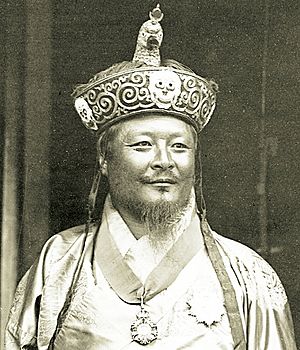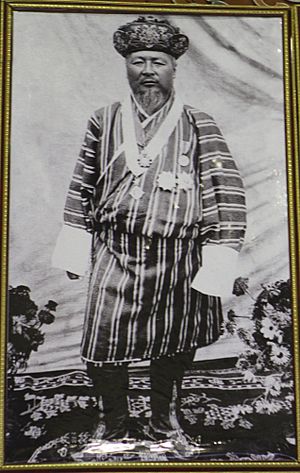Ugyen Wangchuck facts for kids
Quick facts for kids Ugyen Wangchuckཨོ་རྒྱན་དབང་ཕྱུག |
|
|---|---|
| Druk Gyalpo | |
 |
|
| King of Bhutan | |
| Reign | 17 December 1907 – 26 August 1926 |
| Coronation | 17 December 1907 |
| Predecessor | None (hereditary monarchy established) |
| Successor | Jigme Wangchuck |
| Born | 11 June 1862 Bumthang |
| Died | 26 August 1926 (aged 64) Phodrang |
| Burial | Cremated at Kurjey Lhakhang |
| Spouse | Ashi Ludrong Dolma Ashi Rinchen Pelmo Ashi Ngodrup Pemo Ashi Tsundue Pema Lhamo |
| Issue | Princess Sonam Pedron Princess Chimi Yangzom King Jigme Wangchuck Prince Gyurme Dorji Princess Kencho Wangmo Prince Karma Thinley Lhundrub |
| House | Wangchuck |
| Father | Jigme Namgyal |
| Mother | Ashi Pema Choki |
| Religion | Buddhism |
Gongsar Ugyen Wangchuck (Dzongkha: ཨོ་རྒྱན་དབང་ཕྱུག; 11 June 1862 – 26 August 1926) was the first King of Bhutan. He was known as the Druk Gyalpo, which means "Dragon King." He ruled from 1907 to 1926. During his time, he worked hard to bring the country together. He also earned the trust of the people of Bhutan.
Contents
Life of Ugyen Wangchuck
Early Life and Rise to Power
Ugyen Wangchuck was born in 1862. His birthplace was Wangducholing Palace in Bumthang. His father, Jigme Namgyal, was a powerful leader. He was the Druk Desi of Bhutan.
Ugyen learned about leadership and fighting from a young age. He grew up during a time of many battles. This made him a skilled fighter. When he was 14, Ugyen fought alongside his father. They fought against a rebellious leader named Tshewnag Norbu.
In 1877, Ugyen was kidnapped by an enemy. His father, Jigme Namgyal, threatened the kidnapper. Ugyen was then released. Soon after, in 1878, Ugyen became the Penlop of Paro. He was only 16 years old.
His father died in 1881. Ugyen then took on many of his father's duties. He tried to make peace with his father's enemies. He gave gifts to monasteries that had disliked his father. He also showed kindness to those who had wronged his father.
Ugyen then worked to gain more power. He placed people he trusted in important government jobs. In 1882, after a period of civil war, Ugyen became the Penlop of Trongsa. This was a position his father had held.
Ugyen continued to stop any disagreements. Two of his allies, Alu Dorji and Phuntsho Dorji, rebelled against him. They tried to put a monk they chose in charge. This led to the Battle of Changlimethang in 1886. This was the last civil war in Bhutan's history. Ugyen, at 24, won the battle. He ended all internal conflicts. This made him the true ruler of Bhutan.
Founding the Monarchy
Before Ugyen Wangchuck, Bhutan was ruled by 54 different leaders called Druk Desis. This system lasted for 256 years. Ugyen Wangchuck started the monarchy in 1907. He had already been the main ruler for over ten years.
On December 17, 1907, Ugyen Wangchuck was chosen by everyone. Representatives of the people, officials, and religious leaders all agreed. He was crowned the first hereditary King of Bhutan. The ceremony took place in Punakha Dzong. A legal paper about the new monarchy was signed that day.
A British officer, Sir Claude White, was there. He represented the British government. Since that day, December 17 is celebrated as the National Day of Bhutan.
Bhutan's Foreign Relations
In 1904, Ugyen Wangchuck helped as a mediator. He joined a British expedition to Tibet. He helped Britain and Tibet talk to each other.
His next official trip was in 1906. He traveled to Kolkata to meet the Prince of Wales. Ugyen Wangchuck was not yet formally the King. But his role showed he was already the true ruler.
King Ugyen Wangchuck's last trip to India was in 1911. He went to Delhi to meet King George V. King George V was the Prince of Wales whom Ugyen had met earlier.
Sir John Claude White was the British Political Officer for Bhutan. He had great respect for King Ugyen Wangchuck. He wrote that he had "never met a native I liked and respected more." He described Ugyen as honest and straightforward. White also took photos at the King's coronation in 1907.
King Ugyen Wangchuck knew that Bhutan needed protection. He wanted to keep Bhutan safe from conflicts in the region. In 1910, he updated a treaty from 1865. A new rule was added. It said that Bhutan would talk with British India when dealing with other countries. This rule was made because Britain was worried about China and Russia's influence in Tibet.
King Ugyen's Spirituality and Education Efforts
King Ugyen Wangchuck had strong connections with many Buddhist teachers. These included Lama Serkong Dorji Chang and the 15th Karmapa Khachyab Dorji.
In 1894, when he was 33, he started building Kurjey temple. This is an important Buddhist site. He also gave a lot of support to monasteries across the country.
He wanted young Bhutanese people to get a good education. He sent two groups of students to Tibet to study Buddhism. They studied to a high level, called "geshey." These students later became important teachers in Bhutan. They helped spread Buddhist teachings.
He also used his own money to renovate the Swayambhunath Temple in Kathmandu. This is a famous Buddhist pilgrimage site.
King Ugyen also wanted to spread Western education. After his visits to Kolkata and Delhi, he started schools. The first schools were in Lame Goenpa and Wangducholing. They had 14 boys from different parts of Bhutan. Later, more students joined. Some students were sent to missionary schools in Kalimpong. These early students became important officials in the 1930s and 1940s. King Ugyen helped start both Western education and strong Buddhist roots in Bhutan.
Death
In 1926, King Ugyen Wangchuck passed away. He was 64 years old. He died at Thinley Rabten Palace in Phodrang.
Honours
Foreign honours
 British Raj :
British Raj :
 Knight Grand Commander of the Order of the Indian Empire (GCIE) (1921)
Knight Grand Commander of the Order of the Indian Empire (GCIE) (1921) Knight Commander of the Order of the Star of India (KCSI) (1911)
Knight Commander of the Order of the Star of India (KCSI) (1911) Knight Commander of the Order of the Indian Empire (KCIE) (1905)
Knight Commander of the Order of the Indian Empire (KCIE) (1905) Recipient of the Delhi Durbar Gold Medal (1911)
Recipient of the Delhi Durbar Gold Medal (1911)
See also
 In Spanish: Ugyen Wangchuck para niños
In Spanish: Ugyen Wangchuck para niños


